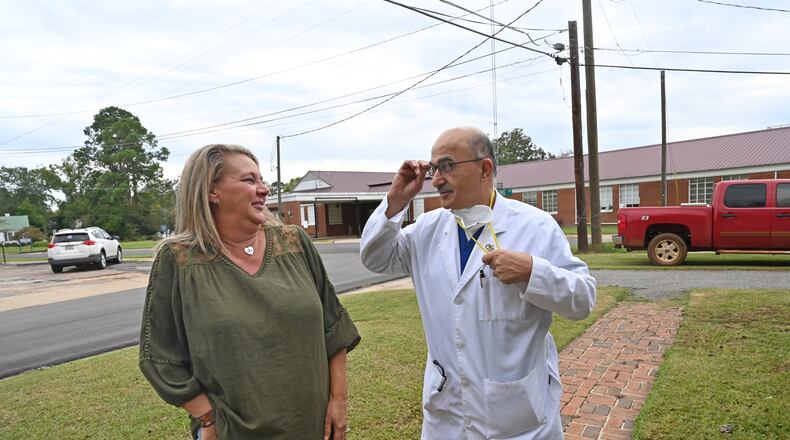In early August, Laura Wiggins spent three days with a chest pain that radiated to her backside. Each time it struck, she had to sit up to breathe.
After a quick trip to the emergency room at her hometown hospital, tests confirmed that the 50-year-old Cuthbert woman had elevated protein levels associated with a heart attack. She received a saline drip, a chewable aspirin and a diuretic to stabilize her condition while waiting to be transported to an acute care facility in Atlanta.
Wiggins was certainly grateful for the immediate attention she received at Southwest Georgia Regional Medical Center, which announced it expects to close by Oct. 22 due to financial hardship. But she is among the first to acknowledge that a hospital that rarely sees more than four patients a day is not equipped to handle a heart attack patient.
For years, Georgia has tried to extend the life expectancy of its rural hospitals, throwing millions of dollars at buildings falling apart from years of wear and tear, with inpatient volumes so low that it was a struggle to stay open and assure patients that the care they were receiving was top notch.
"We’ve done everything to provide aid to these hospitals to try to keep them open,'' said State Rep. Alan Powell, R-Hartwell. “But at the end of the day, you can’t run a facility that is costing $30 million dollars a year to keep open and you’re only filling up with 12 patients.”
Now, in an unusual twist, a chorus of Georgia lawmakers, national policy makers, and even rural advocates themselves says some closures are past due.
"Ultimately, there will be a few more that close,'' said Georgia state Rep. Terry England, R-Auburn, a member of the state’s rural stabilization committee established by former Gov. Nathan Deal several years ago to address the closure crisis. “There is no way to save them. It doesn’t make financial sense. Sometimes, it doesn’t even make physical sense to save a handful.”
And the federal government earlier this month signaled a willingness to create a new healthcare delivery model in the place of many small rural hospitals. Up to now, inflexible federal rules on Medicare payments had blocked overdue reforms, advocates say.
The key challenge is whether changes can be implemented fast enough to avert a domino effect of rural hospital closings, as the coronavirus pandemic further tugs on the finances of many rural hospitals. Northridge Medical Center in Commerce also has announced it will close this month, and the industry is predicting more rural hospitals will go belly up over the next few months.
"It’s really hard to do the work we’re talking about,'' said Brock Slabach, a former Mississippi rural hospital administrator who is now senior vice president for the National Rural Health Association in Kansas. “We’re trying to change the tires on a car going 60 miles an hour. How do we do this quickly so that we don’t crash?”
That work includes figuring out what will happen once rural hospitals close. Where will residents go to seek care? Will there be a supplemental facility available to the poor and elderly to handle emergencies like heart attacks, farming accidents, and other life threats?
In Georgia, one urgent issue will be how to address the gaps in healthcare that will be created by the closure of Southwest Georgia Regional Medical Center.
Credit: HYOSUB SHIN / AJC
Credit: HYOSUB SHIN / AJC
Patients will have to go 30 miles to Albany or to a facility on the Georgia-Alabama border. Travel to those hospitals isn’t easy. Randolph County is geographically isolated with little access to highways. Meanwhile, it is one of the poorest areas in the nation, with a quarter of the population 65 and older.
“We will have to drive an hour to get to something,” Wiggins said. “This is really sad to me.”
‘Got to learn to play the game’
It won’t be the first time Georgia has explored options to replace its rural healthcare model.
About seven years ago, England and members of a statewide rural hospital stabilization committee spent months at rural facilities with health executives trying to hammer out a healthcare structure that would work in less populous areas.
After seeing the financial impact to facilities that couldn’t fill beds with patients, a recommendation was made to shift resources to support a delivery model that could serve patients, like Wiggins, in need of immediate medical attention.
But the effort died quickly as further analysis showed that Medicare at the time would not reimburse the facilities for patients in outpatient and emergency room settings.
Now, barriers like that could be coming down as the federal government is signaling a change that would dramatically transform the core mission of rural hospitals. The bipartisan 2017 Rural Emergency Acute Care Hospital Act, sponsored by U.S. Sen. Chuck Grassley, R-Iowa, Amy Klobuchar, D-Minn., and Cory Gardner, R-Colo., would convert the hospitals into outpatient, urgent care and emergency rooms. Those facilities would serve to stabilize patients, like Wiggins, until they could be transported to larger hospitals.
In an 84-page Rural Action Plan released this month, U.S. Department of Health and Human Services Secretary Alex Azar emphasized a proposal to set up a new Medicare provider type that would allow small rural hospitals designated as critical access facilities to convert voluntarily to emergency rooms without inpatient beds.
"We've done everything to provide aid to these hospitals to try to keep them open. But at the end of the day, you can't run a facility that is costing $30 million dollars a year to keep open and you're only filling up with 12 patients."
Currently, Medicare reimburses those hospitals 101 percent of reasonable costs for most inpatient and outpatient services, but eligibility for these higher payments is tied to meeting certain requirements, including furnishing acute care inpatient hospital services. The new facility type would receive the same Medicare payment rates as other emergency departments paid under the outpatient prospective payment system, plus an additional payment to assist with capital costs.
To help overcome the unsustainable financial models of rural hospitals, the Centers for Medicare and Medicaid Services is promoting another initiative. Its program aims to keep patients out of the hospital in the first place through incentives to providers. More than two dozen rural Mississippi hospitals have served as launch pads for the program, in which nurses were assigned to Medicare patients to monitor their lifestyle choices and prevent a worsening of chronic diseases, such as diabetes, hypertension and heart disease, said Paul Gardner, executive director of the Mississippi Rural Health Accountable Care Organization.
As many as 65,000 Medicare patients signed up, Gardner said.
Last month, CMS issued a notice to release $75 million in seed funding to 15 rural communities for the program, and participating hospitals would be paid stable, monthly payments. The hospitals could also provide patients with transportation and offer gift card rewards and incentives for chronic disease management programs. The federal government would also split cost savings with providers.
While the strategies won’t suddenly slow the pace of hospital closures, Gardner said, they will prepare facilities to adapt to healthcare models that will shape the future of medicine.
“Rural hospitals have got to learn to play the game or they will get left outside looking in,” Gardner said.
Credit: Bob Andres, robert.andres@ajc.com
Credit: Bob Andres, robert.andres@ajc.com
It’s time for the state to acknowledge that many Georgia rural communities cannot support full-service hospitals, said State Rep. Sharon Cooper, R-Marietta.
"Communities often pride themselves in having a hospital, but to be realistic, the communities just can’t afford them,'' said Cooper, who is chairman of the House Health and Human Services Committee.
But it’s not acceptable to leave those communities without healthcare answers, she said. What’s needed may be a freestanding emergency room. Another option would be a hybrid model that would allow patients under observation to spend an additional night at the hospital, she said.
Yet another option could be a statewide effort to expand services at 18 public health districts that serve the state’s 159 counties. In the past, the public was able to receive preventative care from nurses at standalone healthcare facilities sponsored by the public health districts. Similarly, such healthcare centers could be beefed up with technology, including telehealth systems, to reach out to residents without transportation, Cooper said.
"A really robust public health system could be a great first line of defense for communities and making sure that people who need care get seen,'' Cooper said.
Worth saving
Another sensitive question now is which rural hospitals should be saved.
Local elected officials can be reluctant to ask taxpayers to pay more to support their hometown hospital. Yet, if a facility shutters, state leaders will have to face the ire of those communities left without access to healthcare.
"It does become a political hot potato,'' said Powell, the state representative from Hart County, northeast of Atlanta.
Credit: Ben Gray for the AJC
Credit: Ben Gray for the AJC
State Rep. Sam Watson, R-Moultrie, co-chair of the House Rural Development Council, said he was hopeful that federal pandemic relief funds for hospitals would slow the pace of rural hospital closures, at least until lawmakers can come up with a plan.
“We’re always going to be talking about that issue,” Watson said. “It’s something that seems is always on the radar.”
As the discussions get underway, national public policy researchers suggest that states establish comprehensive plans that give priority to saving hospitals in geographically isolated area with large populations of the underserved.
In Georgia, only five of 14 hospitals at a high financial risk of closure were deemed by a national study as most essential to save.
The study, conducted by Washington, D.C. healthcare consultant Guidehouse, evaluated a series of factors to determine the essentiality of a hospital, including the amount of charity care it provided as compared to overall facility charges, how far residents would have to travel to get to the nearest hospital, and the ratio of jobs the facility provided compared to the population of the county.
“Our attempt was to identify which hospitals are in danger of closing, but also which hospitals are the most important to save,” said Ryan Stattenfield, associate director for healthcare at Guidehouse.
“That hospital that’s sort of out in the middle of nowhere, that hospital may be struggling financially but if that hospital were to close, that’s a real hardship for people in that area.”
Among the nine facilities that were not in the highly essential category was Northridge Medical Center in Commerce, which expects to close Oct. 31.
The facility was in a fast-growth part of northeast Georgia, with easy access to highways. In addition, it had an average daily census of three patients, Medicare cost report data show.
"In about 20 minutes, you can be at another hospital, three of which are much newer facilities and much nicer than that one is,'' England said.
A study by Washington, D.C., consultant Guidehouse rated only six of Georgia’s 34 rural hospitals as being at low financial risk. It rated 14 rural hospitals at high financial risk, and five of those as most essential to their communities, including Southwest Georgia, which is closing later this month. Eight of the other hospitals at high financial risk were rated somewhat essential and one as less essential. Here are the five rated as most essential and at high risk:
- Emanuel Medical Center, Swainsboro
- Evans Memorial Hospital, Claxton
- Irwin County Hospital, Ocilla
- St. Mary’s Sacred Heart Hospital, Lavonia
- Southwest Georgia Regional Medical Center, Cuthbert.
About the Author
The Latest
Featured







